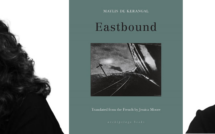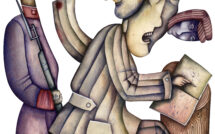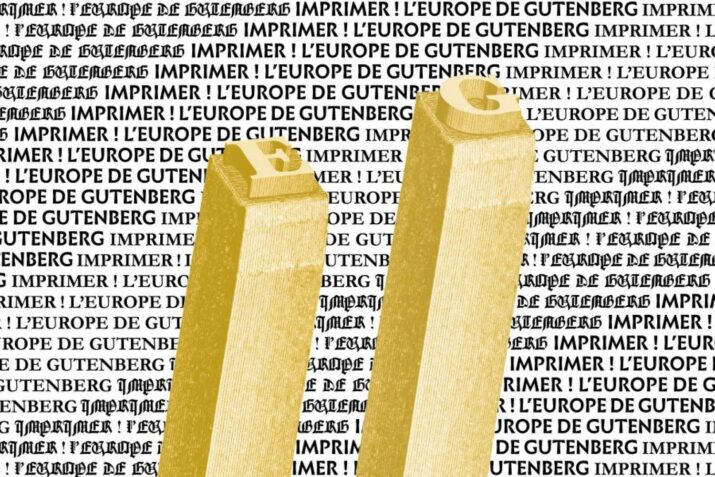
Impressions from France: A Review of the Exhibit “Imprimer! L’Europe de Gutenberg, 1450–1520” at the Bibliothèque Nationale de France
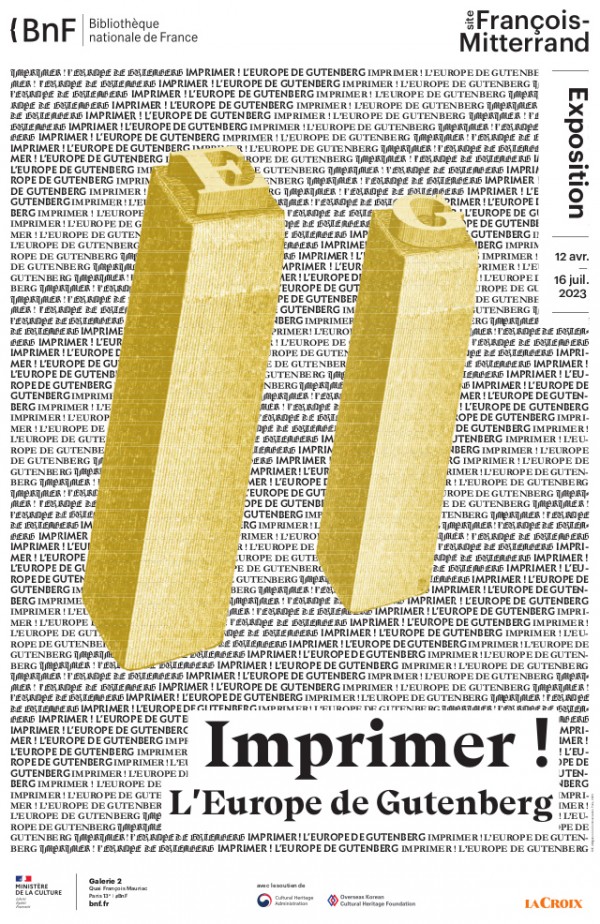
Bibliophiles exist on a spectrum, and scholars who study books tend towards one of two poles: “historicists” can sometimes focus on text and context to the exclusion of the object itself; and “antiquarians” often value a book’s materials and provenance over the information inside it. In this conflict between equal yet opposing forces, the challenge for book lovers is to integrate both approaches. This integration is happening. Drawing on a generation of historians of the book and spurred to new creativity by the increasing availability of digitized texts, library scholars and rare book curators now explore the many ways in which fifteenth-century printed books changed history.
Nowhere can this shift towards a more historical or contextualizing approach be seen more clearly than in how the presentation of rare books has changed at the French National Library (the Bibliothèque nationale de France, henceforth the BnF). An earlier 1996 catalog entitled “Treasures of the BnF” was an antiquarian’s paradise, presenting a mouthwatering trove for bibliophilic veneration.[1] In contrast, the recent showcase under review offers a different approach to the institution’s riches. Entitled Imprimer! L’Europe de Gutenberg, 1450–1520 [Print! The Europe of Gutenberg, 1450–1520], the exhibition displays almost 270 objects that take the viewer from Korea and China to the Low Countries, Germany and Italy, and the far-flung provinces of what would ultimately become mainland France. It moves beyond earlier models by offering the public a comprehensive survey of early print that places Gutenberg in his historical and geographic context, an overview that follows the central precepts of the academic field of book history as it has been studied and taught over the last generation.
The monumental collection focuses, above all, on incunabula—a Latin term referring to books from the “cradle” or infancy of European printing before the year 1501. Beginning with the title itself, the designers of The Europe of Gutenberg sought to step away from the inventor’s formidable shadow in order to suggest alternative predecessors to print technology. The most impressive of these materials was the Jikji: a 1377 volume from Korea that is the oldest surviving example of a book printed with metallic moveable type (fig. 1).[2] As the exhibition text pointed out, it is not clear if these Asian precedents directly inspired later European innovations.[3] Nevertheless, these were welcome additions. Had the exhibition devoted similar attention to the long history of paper, it might have afforded an opportunity to showcase the BnF’s notable collection of papyrus while paying tribute to the Arab perfection of cloth-based paper to which the European print revolution was indebted.[4] In the European context, the exhibition showed how woodblock printing (xylography) and die-cast metal objects such as pilgrim medals both prefigured Gutenberg’s later invention (fig. 2).
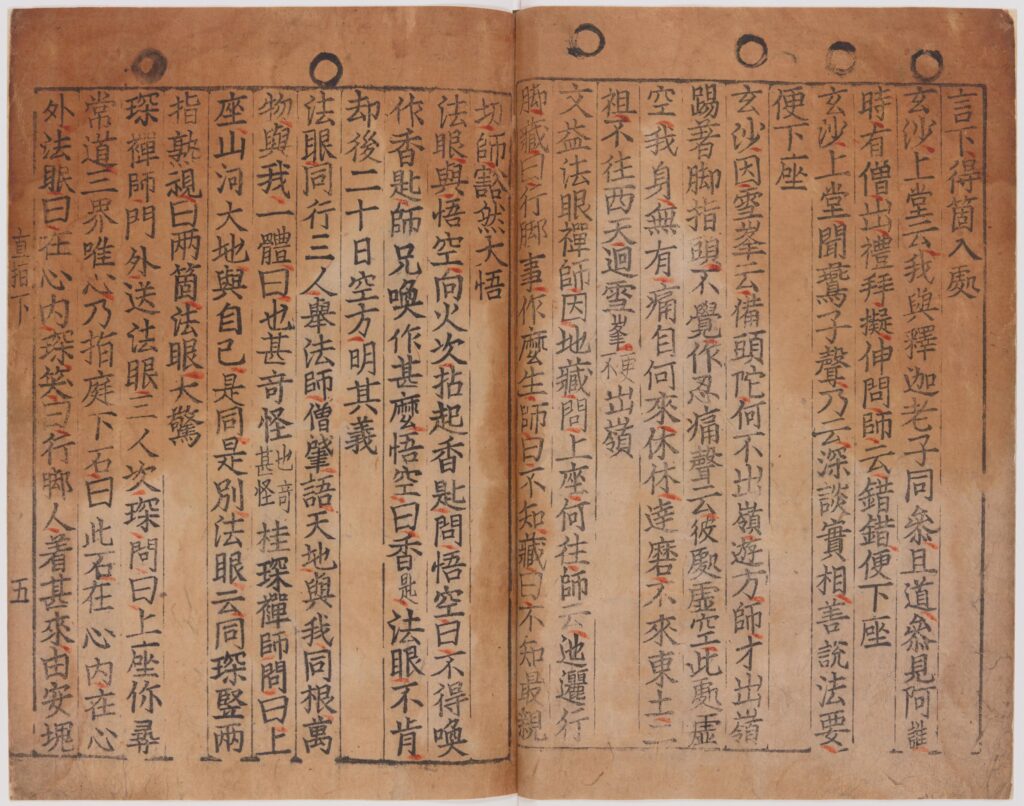
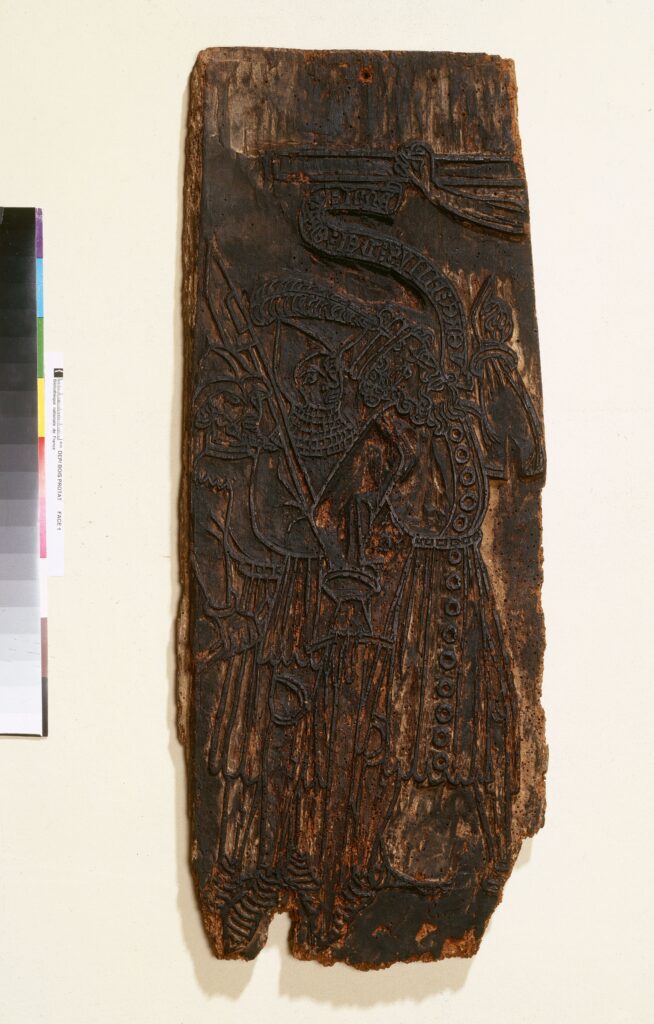
Despite the intentions of the curators, it proved hard to avoid ascribing world-historical agency to Gutenberg. The exhibition even begins with Jean-Antoine Laurent’s 1831 rendering of a bearded Gutenberg at his desk: more an illustration of a nineteenth-century historical imagination than of the man himself. The didactic panels aptly contextualize Gutenberg’s invention: he was not the first printer in the world, nor did he invent print out of nothing. They specify that, “[t]his Romantic image of a solitary genius is no longer current today.” But in the end, the exhibition—like historians—cannot escape the fact that Gutenberg and his partners brought different techniques together in a new way and that this technology in turn transformed Europe.
The greatest strength of Print!: The Europe of Gutenberg lies in the BnF’s vast trove of incunables. Yet while incunables (by definition) were printed before the year 1501, the National Library’s collection only took its present form over the many centuries that followed. It is true that some form of collecting had begun as early as the 1490s. During the Italian Wars, the armies of the short-lived French monarch Charles VIII introduced syphilis to Naples but brought printed books back to France—a favorable trade for his librarians (although it is hard to say which would ultimately prove the more destabilizing force). From his Renaissance château in Amboise, Charles VIII would later add a small number of printed codices to the royal collection.[5] In 1537 under François I, the library even benefited from an early form of copyright deposits (what is now known as dépôt légal). Yet before 1600, that royal library boasted only 1,329 printed documents—a collection that would have fit in a single, large room.[6]
It would ultimately take the long reign of Louis XIV in the seventeenth century for the collection to experience a period of extended growth. The Sun King’s chief minister, Jean-Baptiste Colbert, acquired so many volumes for the royal library that it held 36,000 printed books by his death in 1683.[7] Much as French revolutionaries turned the Louvre Palace into an art museum, the republican government would later nationalize the monarchy’s Bibliothèque Royale and expand the collections by confiscating the libraries of aristocratic émigrés and disestablished religious institutions.[8] As of today, the collection holds over 8,000 incunables.[9] While most of those works arrived centuries after their publication, the institution held a consistent mission throughout these years: to acquire copies of the highest artisanal quality—with colorful illuminations, high-quality paper, and gilt-tooled bindings— that could be said today to form the world’s most comprehensive collection of rare books.
This exhibition’s curators took full advantage of this sizable collection to make an important point: not all editions or copies from the same period are alike. By displaying multiple examples of the same book, the exhibition illustrates the small differences that reveal how print was made. Four copies of a crucifixion scene from Swabia showed how illuminators added slight variations as they fleshed out the details in a monochrome print. This point came through in the exhibition’s ultimate power move: juxtaposing two “Gutenberg bibles” (that is, two volumes on parchment, and two volumes on paper) for comparison. Opened to the same page, the books showed different hand-colored designs. Europe’s first printed books were sold as simple stacks of loose paper, inviting its owners to color in the pages, to adorn initial letters and headings, and to bind the leaves (fig. 3).[10]
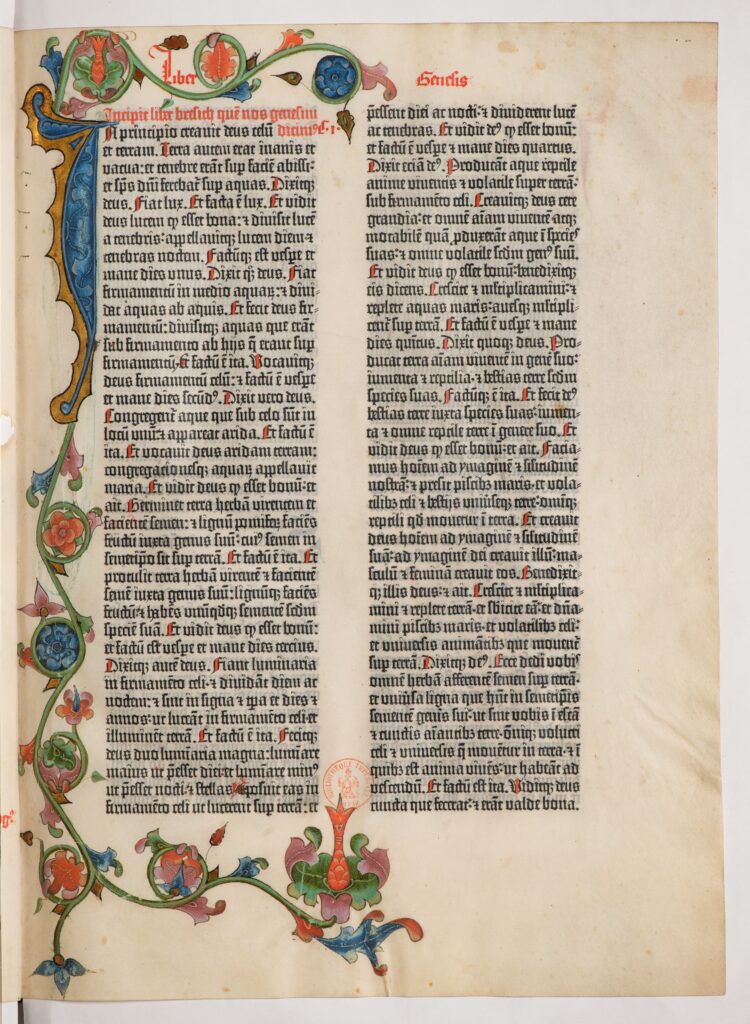
In some ways, however, royal collecting offers a blinkered view of the history of printing: one that is focused on treasures but risks missing some of the ephemera, clerical mistakes, forgeries, and print-house bankruptcies that marked early print.[11] One gets the impression that the stately BnF historically may not have needed to scrounge for the slips, scraps, and printing house blunders that scholars of early modern books have used to reverse-engineer how early print was made and used. The books on display revealed exciting aspects of early print culture, but these were fine editions. Even the marginalia on display were tidy, such as the case of the diligent student who held Guillaume Tardif’s 1474/75 Rhetoricæ artis ac oratoriæ facultatis compendium and evenly inscribed the five canons of rhetoric (inventio, dispositio, elocutio, memoria, and pronunciatio) in the margin.
This corpus captures an important aspect of early print: while experimental, it nonetheless produced dignified products for elites. The move towards print was often led by institutions, especially church and crown, before the spread of news-mongering pamphleteers in the market-driven tumult to come. As book historian Andrew Pettegree put it: “Fifty years after Gutenberg’s triumph print was an inescapable part of the book world. But it was still a world catering mostly for a moneyed and restricted readership, based on a familiar and rather conservative range of texts.”[12] While the exhibition nods to the epistemic crises wrought by print, the show concludes before some of the most dramatic challenges to the medieval politics of truth.
Walking through the exhibition, the visitor could easily forget that print would soon propel an upheaval within European Christendom. This no doubt motivated the curators’ decision to end in 1520. The exhibition nevertheless dropped plenty of breadcrumbs leading from early print culture towards the Reformation: a letter of indulgence printed by Gutenberg in 1454, one of the first dated printed documents in Europe; an account of the Florentine Dominican friar and heretic Girolamo Savonarola, whom Martin Luther viewed as a predecessor to the Reformation, near the end of the exhibition; and an edition of a book by Thomas a Kempis, a priest following religious orders (known as a canon) who preceded Martin Luther in the German city of Windesheim. While the sixteenth-century display rooms of the exhibition did present a German-language copy of the Edict of Worms that condemned Luther in 1521, curators avoided treating the Reformation head-on as one of early print’s most tumultuous consequences.
Given the history of this collection and the target audience, the exhibition itself is very French—without ascribing undue importance to French printers. Where else would you find incunables in regional languages such as Breton or Languedocian—let alone a public capable of appreciating them? The exhibition was of international significance and caliber, but it also catered to its French audience in a manner befitting a national library. A chart on one exhibition panel traced the dramatic rise of books printed not in Latin (the period’s lingua franca), but in French, through the sixteenth century. The label on the late medieval La Farce de Maître Pierre Pathelin (written c. 1456) noted the book was open to the page containing “that famous dialogue” between the lawyer Pathelin and the shepherd—a scene familiar to French baccalaureate students but not to uninitiated “Anglo-Saxons.”
This Francocentric approach also had many advantages. Comparing regional differences around France allows viewers to see how printers had several motives for innovation. In 1470, Sorbonne rector Jean Heynlin and librarian Guillaume Fichet brought the printing press into France to Paris’s Latin quarter. In contrast, the city of Lyon had no university–but its position as a clearing house for international commerce buoyed by favorable local regulations allowed print to become a compelling business opportunity. What is more, the exhibition designers artfully emphasized the ways that many “French” printers, such as the itinerant Johann Neumeister (alias Jean d’Albi), actually worked across different languages and countries, further justifying the “European” moniker of the exhibition as French, German, and Dutch workshops eclipsed the early Venetian printers. By highlighting examples of linguistic diversity within France’s modern borders, the curation team leveraged their French perspective to make wider points about the history of print across Europe.
The final wide hall of the exhibition displayed a range of printed books and broadsheets relating to broader print culture, ranging from liturgical calendars to devotional books of hours and student textbooks—in addition to the Grand Pardon of Notre-Dame de Reims, the oldest printed placard in France.[13] Viewers saw new political uses for print, as well: whereas medieval kings would stage ceremonies such as the royal entry into cities or funeral processions in order to display and consolidate their authority, printed books recorded those rituals—here, Pierre le Caron’s 1498 depiction of the royal entry of Louis XII into Paris, and a 1514 description of the funeral procession for Anne of Brittany. These printed examples of spatially enacted power foreshadow the written constitutions and positive law that would later appear in the Age of Revolutions.[14]
State-of-the-art exhibition technology, combined with top-notch English translations, brought out unexpected richness from well-known works in the BnF’s collection. The audio-video stations with headphones and short documentary clips were just the beginning. In a room devoted to the images that accompanied printed codices, the curators suspended Dürer prints midair to draw attention to the relationship between image (recto) and text (verso). In another case, polished mirrors allowed viewers to admire the underside of a particularly splendid illustrated page. Then, thanks to a leviathan loan from the Gutenberg museum in Mainz, a working 1925 replica of a printing press allowed visitors to watch as an inky-fingered curator set the type, locked it into a forme, and rolled on ink. She then selected an elderly man, grinning like a schoolboy, to pull the lever—and off the press came a printed page (fig. 4). At the next interactive station, children and adults alike plucked letters from a basket and set the type into a rack—with the letters facing backwards, just as they would have appeared to Renaissance compositors. The full bustle of the printing house is hard to capture. The exhibition did include a wall-sized reproduction of Jan van der Straet’s Impressio librorum, which depicts workers inside a printer’s workshop, but only as background to (and therefore obscured by) the chat panels which offered a glossary in French. Nevertheless, these items made it clear that the printing house brought a revolution in mechanical reproduction; that print was a tactile and physical art; and that it was a workplace that invited collaboration from different kinds of experts.[15]
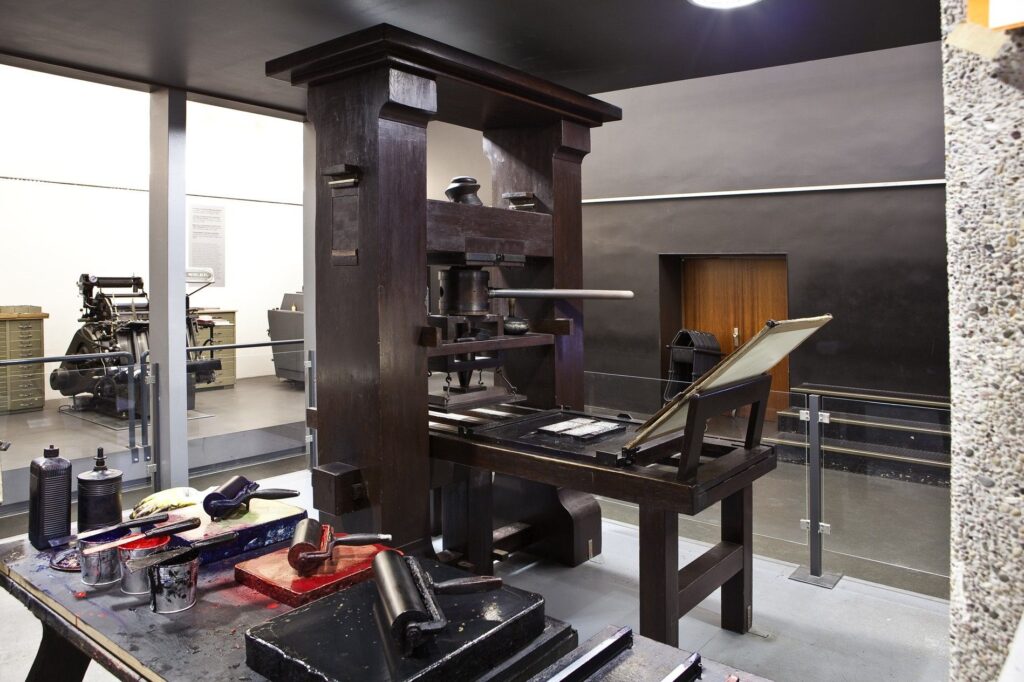
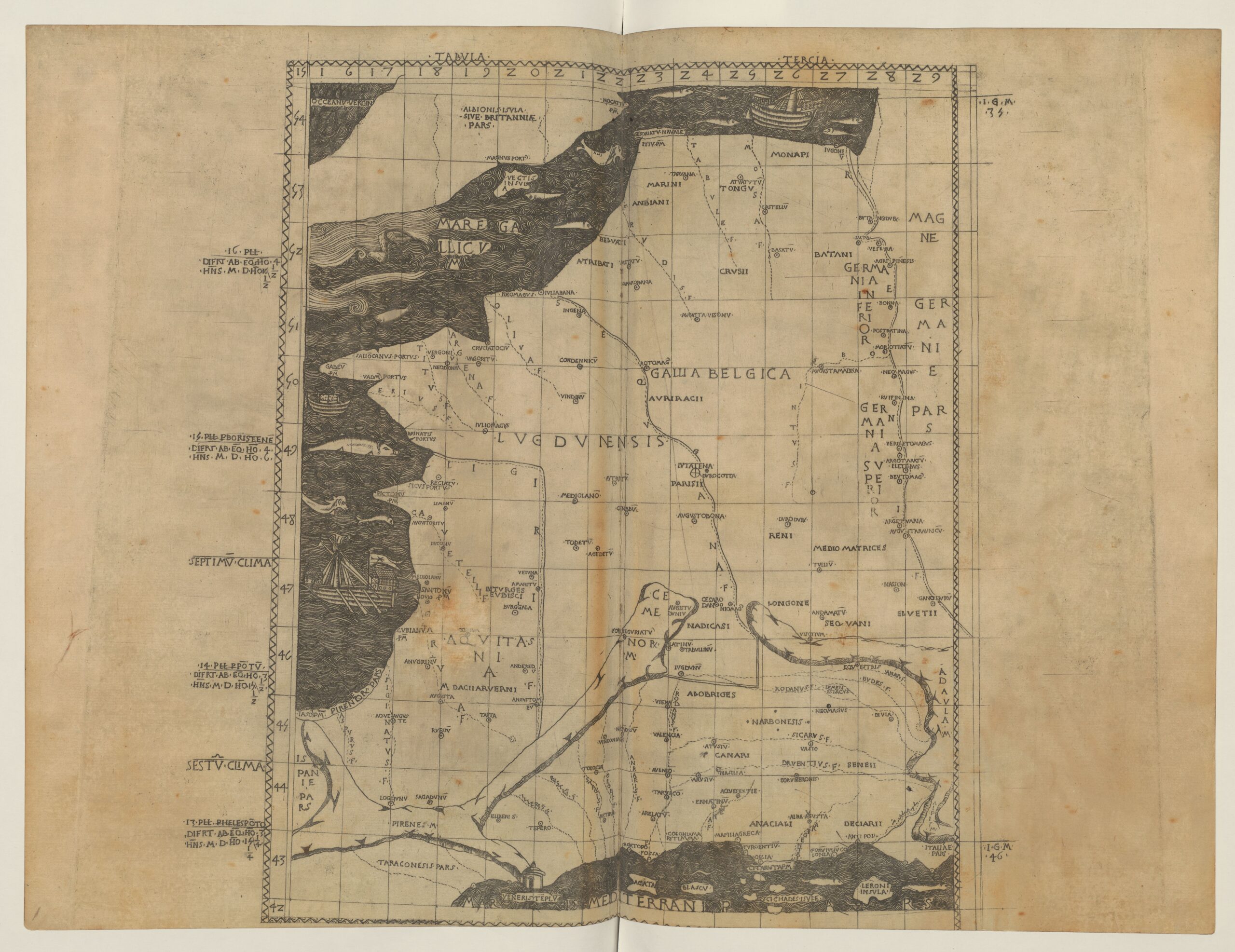
Viewers could learn many other book history basics here. Tables of prices showed how terrifically expensive early printed codices could be, but also how image-heavy books like Ptolemy’s Cosmographia could undercut the prices of their manuscript competitors by a factor of 88 to one.[16] The curators highlighted how one editor annotated their printed copy of Petrarch’s Secretum de contemptu mundi in order to prepare a new edition. They introduced visitors to many problems that required typographical experimentation: how to print music, maps, and non-Latin scripts including Greek and Hebrew. In one masterful room, the exhibition paid particular attention to how printers combined images and text in the same printed books. There were rotating volvelles, which turned books into computation devices. Wall glossaries (again in French) introduced visitors to terms like “intaglio” (taille-douce) or “woodcut” (xylographie); and visitors could compare, side-by-side, these different techniques for engraving images and compare prints with their inverted alter-egos, the matrices or plates.
The French-language exhibition catalog, compiled under the direction of Nathalie Coilly and Caroline Vrand, makes for a useful textbook for early print history. It includes a timeline, a glossary, a map showing the spread of print in Europe, and a bibliography. In contrast to the physical exhibition, the book images take the form of scans of the pages to which the books are open without showing the entire objects themselves. This editorial choice flattens the exhibition’s material heft. Yet in other ways, the book goes beyond the didactic panels by including essays by book historians and bibliographers—Mathieu Arnoux, Olivier Deloignon, Yann Sordet, Christine Bénévent, and Frédéric Barbier—who contextualize each phase of the exhibition’s narrative.
In all, the exhibition brilliantly conveyed what has become a scholarly consensus—maybe even dogma—on the history of early print. To see what we mean, consider a comparison with Princeton University Library’s 2019 exhibition Gutenberg & After: Europe’s First Printers, 1450–1470, curated by Paul Needham and Eric White. Thanks to the rich holdings of incunables in Princeton’s Scheide Collection, the time period and topics were similar to the BnF’s later exhibition. But the similarities run deeper than that. Both teams selected many of the same “greatest hits” off the incunable soundtrack. Now that we have seen both the Princeton and BnF exhibitions, we can say we have seen two exempla of Neumeister and Evangelista’s 1472 printing of Dante’s Divine Comedy… Both showed off Gutenberg’s Catholicon press editions. It was important to include, in both narratives, the 1457 psalm book created by Gutenberg’s erstwhile partners Fust and Schöffer after the band broke up. And between the two exhibitions, there were three Gutenberg Bibles on display. Like the BnF’s show, Princeton also brought viewers into the workplace of the print shop, although the Americans did so by showing one of just two extant copies of the 1499/1500 Lyons Grant Danse Macabre: for, it contains the earliest image of a print shop in a printed book. All this to say: these librarians largely agree on how this story goes. For our part, we might wish that the field of library exhibitions would become more unruly in the coming years: to allow for disagreement and to find new angles for presenting rare books, even five centuries old, to the public.
Despite their common objects, overlapping bibliography, and similar narratives, these two exhibitions still look different. The same “French” additions that might seem foreign to an American viewer—the knowing references to the play Maître Pathelin, or an incunable printed in Breton—were precisely what gives this exhibition (and the BnF collection as a whole) its value. As a point of contrast, the Princeton exhibition focused somewhat more tightly on Gutenberg’s career, carrying viewers step by step through various technological innovations, the design of new typefaces, and the rise and fall of his partnerships. It also emphasized longue durée print culture in ways that the BnF did not. To illustrate binding waste and reuse, Princeton displayed a new 2017 acquisition: a remarkable 1666 German law manual that a seventeenth-century bookbinder had bound with a leaf from a Gutenberg Bible. Today’s treasure was once a bookbinder’s trash, and trash was not something the Bourbons or Bonapartes, who all played a role in the BnF’s acquisitions history, tended to collect. So even though both exhibitions had a similar conceptual framing, the centuries-long history of the BnF’s collection makes for a unique visiting experience, one that will satisfy both the historian and the antiquarian in each of us. Only the BnF could have pulled it off.
Benjamin Bernard is an interdisciplinary Postdoctoral Research Associate in the College of Arts and Sciences at the University of Virginia and a lecturer by courtesy in the Department of French. He received his PhD in early modern history from Princeton University in 2022. His current project, The Moral Authority of Classical Education Institutions in Early Modern Paris, weaves together the histories of gender and sexuality, education, and ideas to trace the rise and fall of the “collège” as an institution of moral authority in early modern France.
Matthew McDonald is a Fulbright Scholar in Paris who received his PhD in early modern European history from Princeton University in 2022. In October 2023, he began a Marie Skłodowska-Curie fellowship jointly at the University of Trier and Sciences Po. His current project, “Global Lingua Franca,” explores the spread of French as an international language before the rise of global English.
The authors thank Paul Babinski for his comments on an earlier draft of this article.
[1] Marie-Hélène Tesnière, Marie-Odile Germain, and Antoine Coron, eds. Trésors de la Bibliothèque nationale de France, in two volumes (Paris: Bibliothèque nationale de France, 2001 [original ed. 1996].
[2] “Le ‘Jikji’, un trésor de l’imprimerie,” website of the Bibliothèque nationale de France: https://www.bnf.fr/fr/le-jikji-un-tresor-de-limprimerie.
[3] Recently, Kristina Richardson has proposed that the Roma, who migrated from the medieval Islamic world into the Holy Roman Empire, may have also shared certain early printing techniques: Kristina L. Richardson, Roma in the Medieval Islamic World: Literacy, Culture, and Migration. London, New York, NY: I.B. Tauris, 2022.
[4] Daniel Bellingradt, “The Paper Trade in Early Modern Europe: An Introduction,” in Daniel Bellingradt and Anna Reynolds, eds. The Paper Trade in Early Modern Europe: Practices, Materials, Networks. Leiden: Brill, 2021, 1; Andrew Pettegree, The Book in the Renaissance. New Haven: Yale University Press, 2010, 17.
[5] This exhibition featured that royal provenance in the luxury items printed by Antoine Verard (d. ~1513) for Charles VIII.
[6] BnF, ed. Chevalier. La Bibliothèque Nationale, 1988.
[7] Colbert’s personal collection held another additional 23,000 volumes. Bibliothèque nationale de France, Into the Twenty-First Century. Translated by Ilona Bossanyi. Paris: Bibliothèque nationale de France, 1998, 52; Jacob Soll, The Information Master: Jean-Baptiste Colbert’s Secret State Intelligence System. Ann Arbor: University of Michigan Press, 2009, 103.
[8] Bruno Blasselle and Gennaro Toscano, eds. Histoire de la Bibliothèque Nationale de France. Paris: Bibliothèque Nationale de France, 2022; Franklin, Histoire de la Bibliothèque du Roi; BnF ed. Alix Chevallier, La Bibliothèque Nationale, 1988, 6; Marcel et al., La Bibliothèque Nationale. Paris: Renouard, 1907; BnF trans. Bossanyi, Into the Twenty-First Century; Bette Oliver, From Royal to National: The Louvre Museum and the Bibliothèque Nationale. Lanham, MD: Lexington Books, 2006; Kristian Jensen, Revolution and the Antiquarian Book: Reshaping the Past, 1780-1815. Cambridge: Cambridge University Press, 2011.
[9] An earlier tally from 1988 estimated 12,000 books. Laurence Engel. “Préface,” in Coilly and Vrand, eds., Imprimer!, 9; BnF, ed. Chevalier. La Bibliothèque Nationale, 1988.
[10] Early printed books were sold similarly, but these practices soon changed: Pettegree, The Book in the Renaissance, 53.
[11] On printing and street life, see pp. 216–219. On pirated editions, see Frédéric Barbier’s contribution to the exhibition catalog: “Conclusion: La Renaissance, critique de l’imprimerie.” On Renaissance forgery, see: Anthony Grafton, Forgers and Critics: Creativity and Duplicity in Western Scholarship. Princeton: Princeton University Press, 1990. For a discussion of the Catholic Church’s fifteenth-century adoption of print, see: Margaret Meserve, “The Papacy, Power, and Print: The Publication of Papal Decrees in the First Fifty Years of Printing.” In Print and Power in Early Modern Europe (1500-1800), edited by Nina Lamal, Jamie Cumby, and Helmer J. Helmers. Leiden, Boston: Brill, 2021.
[12] Pettegree, The Book in the Renaissance, 62.
[13] On single-sheet printing, see: Andrew Pettegree, ed. Broadsheets: Single-Sheet Publishing in the First Age of Print. Leiden: Brill, 2017. On “Flugblatten,” the fifteenth-century predecessors to sixteenth-century print culture, see: Falk Eisermann, “Mixing Pop and Politics: Origins, Transmission, and Readers of Illustrated Broadsides in Fifteenth-Century Germany”, in Incunabula and their Readers.
[14] On print and the royal entry, see: Joël Blanchard, “Les spectacles du rite: les entrées royales,” Rève Historique 305/3 (2003), 475–519, cited in Andrew Pettegree, The French Book and the European Book World. Leiden: Brill, 2007, 20.
[15] Anthony Grafton, Inky Fingers: The Making of Books in Early Modern Europe. Cambridge, Massachusetts: Harvard University Press, 2022.
[16] The price table on display stated that a manuscript copy of Ptolemy’s Cosmographia cost 6,200 soldi while the print version cost only 70.
Published on November 21, 2023.

